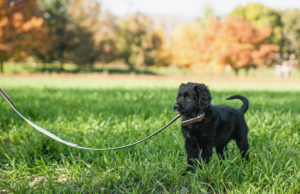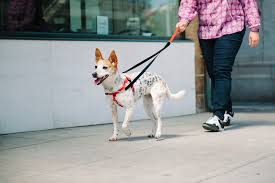You envisioned nice, relaxing walks where you could go out, unplug, and enjoy the company of your puppy. Instead, you’re being yanked all over the place. All you can think of is how if things keep up at this rate, you’re going to need shoulder surgery when your puppy is full grown. Now, instead of looking forward to walks, you dread them. I’ve got tips to stop puppy pulling and for mastering leash walking woes.
Don’t fret! This isn’t your destiny.
Why do puppies pull on leash?
- They have four legs, and we have two. Your puppy is going to have a different stride and walk faster than you- basically, we are slowing our dogs down.
- Pulling gets your puppy where they want to go- there’s lots to sniff and explore. Everything exciting is beyond their leash.
- The main reason puppies pull on leash is because it’s being rewarded. Pulling gets them where they want to go.
How do I stop my puppy from pulling on leash?
- First, make sure you have the right equipment. All training tools are not created equal. Use a front clip harness (I’ll share some of my favorite pieces of equipment in just a little bit).
- Start training! Walking slow and near us is not a natural dog behavior. Polite leash walking has to be taught. It’s not going to happen on its own. Pulling is what is natural and that will happen on its own at no fault of our puppies.
- Use the right rewards that will motivate your puppy. Food and toys are powerful incentives and motivators for your puppy. Food rewards typically work best because you deliver them fast and get more repetitions complete in a shorter amount of time (time is a commodity for us. Who doesn’t want to get more done in less time?)
- To begin with, start at a kindergarten level when teaching polite leash walking. Avoid attempting to train your puppy to walk politely on leash in distracting environments like parks, busy streets, or farmer’s markets. Those are Jedi Master level challenges that can hinder your puppy’s focus and lead to frustration. Instead, opt for starting at home. Here’s a helpful tip: beginning inside your house will be easier than starting in your backyard, where tempting squirrels may distract your puppy.
- Pick which side you would like your dog to walk on- your left or your right
- Start small, at first rewarding one step at a time. This seems tedious and as if it will take forever to teach your puppy to walk politely on leash. Teaching polite leash walking take time and patience. It is one of the harder behaviors to teach (which is why you see so many dogs pulling their guardians down the street). Once your puppy starts to understand what you are looking for, you’ll be well on your way to taking more steps in no time.
The Hard Truth About Teaching Polite Leash Walking
I’m not going to sugar coat it. Polite leash walking is one of the more challenging behaviors to teach. It’s not going to happen overnight. You are at a disadvantage the second you walk out the door because of all the distractions that are enticing your puppy to pull forward.
I said it was a challenging behavior to teach. I did not say it was impossible. It will happen, but the hard truth is you have to put the effort into it. It bears repeating… you will need time and patience (a lot of patience) to teach your puppy to walk politely on leash, but it will pay off in the end. When you are consistent in your training, you will see quicker results.
I know what you are thinking… So, what are you supposed to do in the meantime? How are you supposed to take your puppy for a walk if all they are going to do is pull?
Here are my easy tips to get your puppy out for a walk without messing up your polite leash walking training.
- Take your puppy out to play before going for a walk. Get some of those ya-yas out before you head out for a walk. A jazzed up puppy is going to pull a lot more than a puppy who had a nice romp and expelled some pent up energy.
- Use a long line on your walk. Not a flexi lead/retractable leash. A long line is just a long leash. You can purchase them in different lengths. I have a variety of lengths to use, depending on where I’m walking. I might use a 10 or 15 foot long line in busier areas and a 30 foot long line while out on a trail or less populated area. Puppies often only need a little more room to walk to avoid pulling. Remember, they have four legs and we have two so they are going to walk faster, naturally.
A Little More on Long Lines (leashes)
Are you are making a funny face and thinking, “but won’t my puppy pull even more if they have a longer leash”? Well, here’s the secret: I have found that by giving puppies a little more leash, they can walk, sniff, and explore without pulling.
Puppies often just need a little more space to compensate for their faster stride. This gives them the ability to walk and sniff without pulling on the leash. When there is a tight leash and your puppy walks, your puppy is learning that a tight leash gets them where they want to go. However, when you walk your puppy on a long line/leash, they are learning that a leash with slack gets them where they want to go.
My favorite tools and equipment
Harness
- My favorite piece of equipment for polite leash walking is the Freedom No Pull Harness by 2 Hounds Design. This harness has a front clip and a back clip. There is a double ended leash that allows you to clip the leash on both the front clip and the back clip to help give you more control when you are walking. The Freedom No Pull Harness is easy to put on and if you want to ensure your puppy looks spiffy, there are many fun colors and patterns to choose from.
Rewards
- Food treats play a crucial role in successful polite leash walking training. However, you need to outshine everything else in the environment. Opt for small bits of cheese, meatballs, hot dog, or other soft, moist, and aromatic treats. Avoid dry cookies or prepackaged treats that won’t hold enough value. You want your puppy to believe the polite leash walking is better than any other temptation. After all, the environment is your competition. Remember that iconic Klondike Bar commercial? We want your puppy to experience that same level of motivation.
Other Important Equipment
- Long line- I prefer long lines which are made of biothane. They are odor resistant and clean easily. If they get wet, they dry faster than a nylon long line (which can eventually dry rot and break). My favorite long lines are made by High Tail Hikes. They are small business and I really like to support small businesses. The best part is you get to order the length you want and you get to customize your colors. You can order a long line that fits your personality. I’m such a fan of these long lines, I have an affiliate link and you can order easily, here.
Feeling frustrated by your puppy’s lack of leash skills and other puppy predicaments? Yes, I need help with polite leash walking and other challenges.












